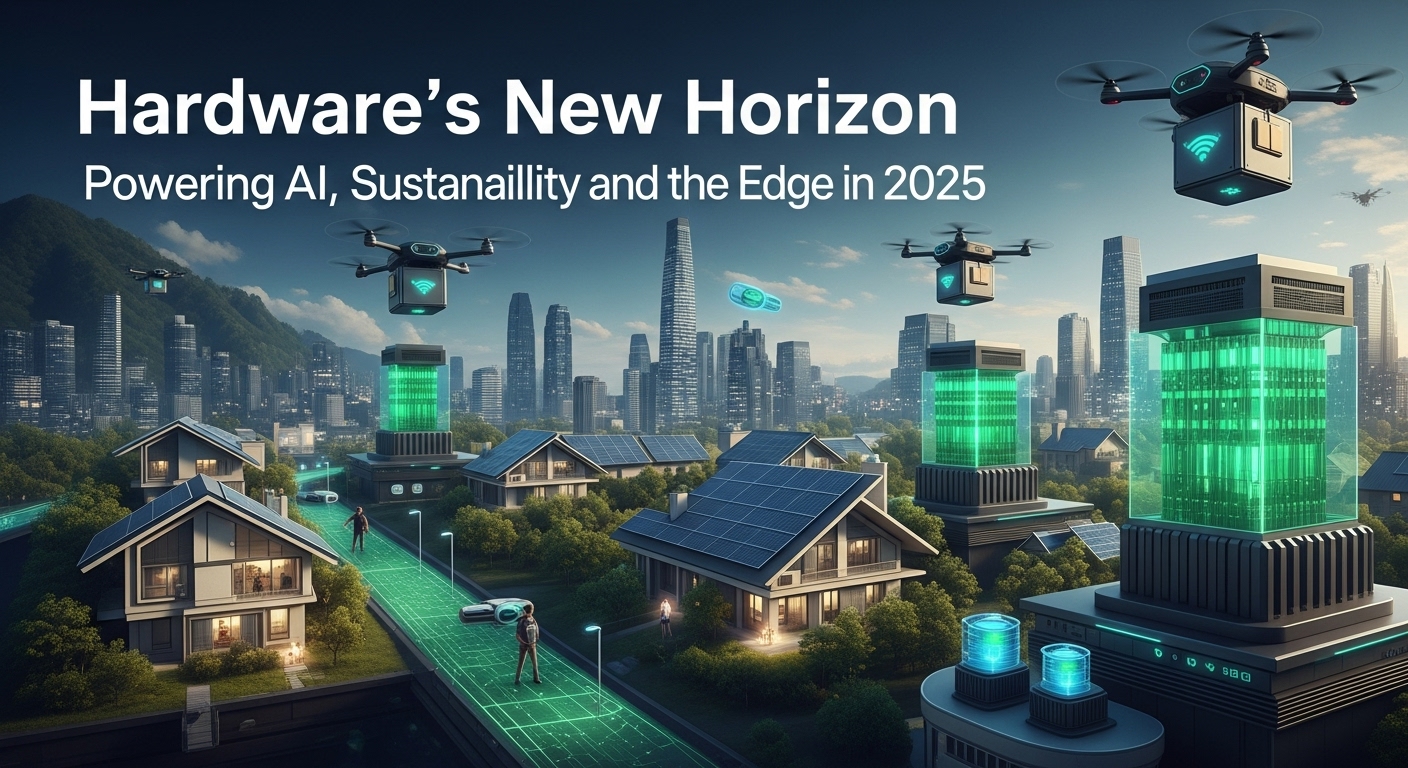While software often commands the spotlight for its dynamic user experiences and intricate logic, “hardware” remains the unsung, tangible foundation of our entire digital world. It’s the physical infrastructure – from the microchips in our smartphones to the towering racks of servers in data centers – that makes every digital interaction possible. As of mid-2025, hardware is not just evolving incrementally; it’s undergoing a revolutionary transformation, driven by the insatiable demands of AI, a profound commitment to sustainability, and breakthroughs in material science that are pushing the boundaries of what’s physically possible.
The Unseen Engine: Core Hardware Components in 2025
The internal components of our devices are becoming increasingly sophisticated:
- Central Processing Units (CPUs) with Integrated AI Accelerators: The “brain” of the computer, CPUs are now commonly integrating Neural Processing Units (NPUs). These dedicated AI accelerators bring powerful AI processing directly to personal devices, enabling faster, more private on-device AI operations. Leading designs from Intel (like Arrow Lake and Lunar Lake) and AMD (Zen 5/Ryzen 9000 series) are in fierce competition, focusing on optimizing AI workloads directly at the chip level. Korean researchers have recently developed NPU core technology that can improve generative AI inference performance by over 60%, showing the rapid pace of innovation.
- Graphics Processing Units (GPUs) for AI Workloads: GPUs are no longer just for gaming or graphics rendering. Their massive parallel processing capabilities make them the undeniable workhorses of Artificial Intelligence and Machine Learning. New generations, like NVIDIA’s Blackwell series and AMD’s RX 90 series, are designed for immense computational power and energy efficiency, though managing their significant power demands remains a key engineering challenge. By 2025, GPUs will dominate enterprise AI workloads worldwide, with over 40,000 companies and 4 million developers depending on NVIDIA GPUs for AI projects.
- Next-Generation Memory and Storage: DDR5 RAM is solidifying its position, offering higher bandwidth and lower latency. More critically, PCIe 5.0 Solid State Drives (SSDs) are setting new benchmarks for speed, offering significantly faster read and write capabilities, which are essential for handling the massive datasets required by large AI models and complex applications. 2025 is expected to be a pivotal year for widespread PCIe 5.0 SSD adoption due to more affordable drives, improved cooling solutions, and game developers starting to factor in these speeds for new releases, alleviating “subtler, modern versions of loading screens.” Specialized high-bandwidth memory (HBM) is also becoming standard for AI accelerators in data centers.
- Motherboards and Cooling Systems: As components grow more powerful and generate more heat, motherboards are evolving to accommodate higher power delivery and faster interfaces. Advanced cooling solutions, including sophisticated air cooling and widespread adoption of liquid cooling (with innovative designs like wrap-around display coolers), are crucial for maintaining stable performance and preventing thermal throttling, which can cause performance degradation.
The New Era of Interaction: External Hardware and Peripherals
Our interfaces with the digital world are also seeing significant advancements:
- Spatial Computing Devices: Products like Apple Vision Pro, Microsoft HoloLens 2, and Meta Quest 3 are redefining how we interact with digital content in the physical environment. These devices blend real and virtual worlds, making augmented and virtual reality (VR/AR) experiences more immersive and user-friendly, pushing the boundaries of traditional displays and moving spatial computing into the mainstream for businesses in sectors like manufacturing and healthcare.
- Advanced Networking Hardware: The widespread expansion of 5G and ongoing research into 6G are driving the development of faster, more reliable network interface cards, modems, and routers. While commercial 6G services are expected around 2030, pre-commercial trials and early proof-of-concepts (like optical AI accelerator chips for 6G edge devices) are emerging in 2025. This is essential for seamless cloud connectivity, real-time communication for autonomous systems, and the proliferation of edge computing.
- Brain-Computer Interfaces (BCIs): While still emerging, BCIs are expanding human potential, allowing direct neural commands for controlling devices. The BCI technology market is estimated at $2 billion in 2025, driven by advancements in neuroscience and miniaturization. Non-invasive BCIs are gaining interest for consumer applications like gaming and entertainment, although high costs and regulatory hurdles remain challenges.
Driving Forces: Key Trends Shaping Hardware in 2025
Several megatrends are fundamentally transforming hardware development and manufacturing:
- AI-First Hardware Design: Hardware is increasingly being designed from the ground up for AI. This includes specialized AI chips (ASICs) optimized for inference, which are more energy-efficient and cost-effective than general-purpose GPUs for many AI workloads, particularly at the edge. The race to deliver superior AI performance is pushing chip manufacturing to unprecedented levels of miniaturization (2-nanometer and even 1.4-nanometer technologies). This shift is driving new processor companies and a focus on open-source hardware architectures.
- Sustainability at the Core: Manufacturers are under growing pressure to produce more sustainable hardware. This involves using recycled metals, biodegradable plastics, and responsibly sourced materials. Low-impact manufacturing processes are reducing the carbon footprint, and companies are offering longer warranties and repair programs to extend product lifespans and minimize e-waste. Commercial hardware trends in 2025 emphasize integrating sustainability, with net-zero carbon products and recycled metals becoming key focuses.
- Edge Computing Proliferation: The exponential growth of IoT devices and the demand for real-time data processing are driving computing to the “edge” of networks. Edge devices, equipped with their own AI processing capabilities (often specialized inference chips), are becoming crucial for applications ranging from autonomous vehicles and smart cities to industrial automation, reducing latency and reliance on centralized cloud networks. Edge AI enables faster, on-the-spot decision-making, improving bandwidth efficiency and enhancing privacy.
- Beyond Moore’s Law & Novel Architectures: While traditional silicon scaling faces physical limits, innovation is thriving in new chip architectures. This includes 3D chip stacking (integrating multiple layers of circuits for higher density), a market projected to reach approximately $15 billion in 2025 due to demand for performance in HPC and AI. Photonic computing (using light instead of electrical signals for faster and more energy-efficient data transfer), is seeing breakthroughs in quantum photonics and optical AI accelerators. Neuromorphic architectures (mimicking the human brain’s structure for highly energy-efficient AI processing) are poised to revolutionize edge AI, consuming 0.1% the power of GPUs for real-time tasks.
- Supply Chain Resilience Amidst Geopolitical Tensions: Global geopolitical conflicts remain a top threat to technology hardware companies in 2025, contributing to inflation and price concerns. Manufacturers are prioritizing supply chain diversification, localized production, and more robust logistics to ensure consistent component availability. Companies like Cisco are actively cutting tariff exposure by diversifying manufacturing footprints, and digital twins are revolutionizing supply chain visibility.
- Human-Centric Design and Personalization: Beyond raw performance, there’s a growing emphasis on hardware that enhances user experience through intuitive interfaces, ergonomic designs, and accessibility features. Customizable hardware finishes are expanding to allow personalization of devices, from kitchen appliances to PC cases, reflecting a desire for unique aesthetics. Inclusive design, including voice-first and gesture-based interfaces, is a key UX trend in 2025 for hardware.
- Quality Control and Accountability: There’s a growing call for better testing and accountability from manufacturers before product launch. Reports of common computer hardware problems like overheating and component failures highlight the continuous need for robust quality assurance and greater responsibility from hardware companies.
The global hardware market is projected to reach over $135 billion in 2025, driven by the demand for automation in manufacturing and the increasing adoption of AI. Hardware remains the fundamental bedrock of our digital existence. As we venture further into an era dominated by ubiquitous AI, hyper-connectivity, and immersive experiences, the continuous evolution of hardware will be paramount in transforming futuristic concepts into tangible realities, silently empowering every digital leap forward.

